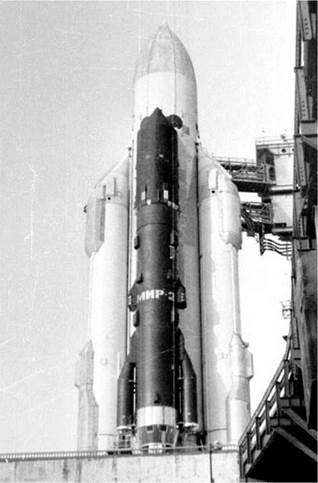ENERGIA FLYS WITH POLYUS
On the 15 May 1997 the Soviet Union achieved something that had eluded it for many years, the launch of a heavy lift booster. As we have seen in earlier chapters the ill-fated N-1 moon rocket endured four failures before its cancelation, but the brand new Energia rocket was launched successfully first time. The payload for its maiden launch seemed a very simple one at first glance. The Soviets reported that it was a mock-up of a manufacturing and material processing platform known as Polyus, future versions of which would be used either as add-on modules for existing space stations, or as free-flying platforms for particular missions. It had a mass of about 80 tonnes and was slightly larger than the existing Mir base block. Unfortunately, in
|
Polyus on first Energia—note “Mir-2” written on the side |
this case the platform did not perform as designed; whilst the Energia rocket performed perfectly, the payload fired its own insertion engine at the wrong orientation and propelled itself back toward the Earth, destroying itself in the process.
Equally unfortunately, all of the above description of the payload from the Soviets was totally inaccurate. Polyus was indeed its name, and it did weigh about 80 tonnes, but in actual fact Polyus was a military orbital weapons platform prototype, a system that apparently Soviet Premier Gorbachev had ordered not to be launched in order not to jeopardize his delicate negotiations with U. S. President Reagan. Basically, Polyus was the Soviet’s response to Reagan’s “Star Wars” Strategic Defense Initiative. It consisted of many pre-existing space components like a TKS tug, which was similar in design to the FGB or Functional Cargo Block that would be launched as Zarya, the first component of the International Space Station (ISS) many years later. It was also thought to include defensive armaments, and test targets that could be released to test its on-board weaponry. None of these features were ever confirmed, and in fact very little information on this “battle platform’’ has ever come to light. The answers lie at the bottom of the Pacific Ocean for anyone that wishes to look.











